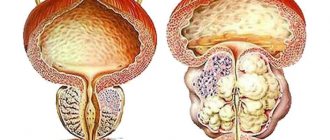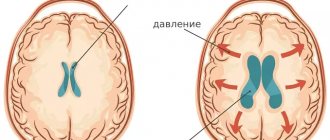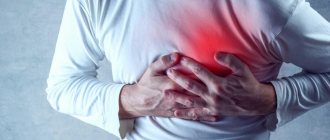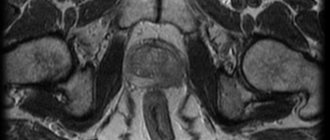Proctitis is an inflammatory disease that is localized in the rectum. First of all, it affects the intestinal mucosa. Very often, proctitis occurs together with sigmoiditis - inflammation of the sigmoid colon (in this case we are talking about proctosigmoiditis).
According to WHO, the risk of developing this disease is observed in 60% of residents of developed countries. Therefore, it is important to remember that early diagnosis plays an important role in the treatment of this disease. Over time, untreated proctitis develops complications and becomes chronic.
At CELT you can get a consultation with a proctologist.
- Initial consultation – 3,000
- Repeated consultation – 2,000
Make an appointment
Causes of the disease
The cause of the disease is the inflammatory process. The reason for the development of the disease can be a variety of factors:
- Excessive consumption of hot foods, spices and alcohol (proctitis of nutritional origin).
- Gonorrheal – occurs as a complication of gonorrhea, usually due to incorrect treatment of the underlying disease.
- “Congestive” – this form affects people suffering from constipation. It may occur against the background of trauma to the intestinal walls.
- Radiation – occurs after a course of radiotherapy aimed at the pelvic organs. Currently, innovative irradiation techniques are used, and the risk of developing radiation proctitis is reduced. Previously, this form of the disease was quite common.
- The parasitic form affects individuals suffering from parasitic intestinal infestations by protozoa and helminths.
There are diseases and conditions that do not directly cause proctitis, but contribute to its development and seriously increase the risk of the disease:
- Hypothermia.
- Inflammation, intestinal injury.
- Haemorrhoids.
- Infectious diseases of the rectum.
- Anal fissures.
- Paraproctitis.
- Abscesses of the intestinal wall.
- Inflammatory diseases of neighboring organs.
- Infectious diseases of the genitourinary system.
Symptoms and forms of the disease
Based on clinical manifestations, there are two main forms – acute and chronic. These two varieties most clearly differ from each other in the symptoms and complaints of the patient.
- It begins suddenly, without preconditions or malaise.
- Body temperature rises to 38-40 degrees.
- Chills occur.
- False urges to go to the toilet appear, and at the same time constipation appears.
- Pain in the rectum is often accompanied by a feeling of heaviness.
- There is a burning sensation and itching in the anal area.
- There may be blood in the stool.
Acute proctitis occurs quite rarely, much more often patients present with the chronic form. At the same time, an acute disease occurs with great discomfort for the patient. The patient's subjective sensations are very unpleasant. Symptoms of the acute form force you to consult a proctologist immediately.
There are several morphological forms of acute proctitis:
- Catarrhal hemorrhagic proctitis. This form of the disease is characterized by severe swelling of the intestinal mucosa. Non-systemic submucosal hemorrhages (hemorrhages) occur.
- Catarrhal mucous proctitis is characterized by the accumulation of large amounts of mucus in the intestinal lumen.
- Catarrhal purulent proctitis is characterized by the presence of pus on the surface of the edematous mucosa.
- Separately, the polypous form is distinguished when, upon examination, polyps are detected on the intestinal mucosa.
- Erosive, ulcerative proctitis is a special form. It is characterized by the formation of long-term non-healing erosions and/or ulcers on the rectal mucosa.
Ulcerative proctitis is one of the most severe forms of proctitis. Upon examination, you can find many lesions and ulcers on the intestinal walls. The course of the disease is characterized by the slow spread of the pathological process; inflammation affects one part of the intestine and spreads further. This may be a manifestation of a serious inflammatory disease - nonspecific ulcerative colitis (UC).
What is a fistula
A fistula is a pathological, normally non-existent, passage in the form of a tube connecting the lumen of a hollow organ with the external environment or the lumen of another organ. A rectal fistula, a kind of “tunnel,” connects the lumen of the rectum with the skin of the perineum, buttocks or (rarely) other hollow organs, sharply reducing the patient’s quality of life. This pathological process can involve a large portion of sphincter muscles, which initially characterizes such a fistula as complex and does not allow for “minimally invasive” treatment. In such a situation, a careful assessment of the degree of involvement of muscle structures and planning of special techniques for economical excision of the fistula with subsequent plastic closure of the resulting defect are required.
Important! Such operations must be performed by expert surgeons with extensive experience in such interventions, otherwise the likelihood of relapse (recurrence of the disease) increases several times.
Fistulas have the following structure:
- internal opening: it is usually the affected anal crypt (that is, the most terminal part of the gland duct). The crypt is connected by a duct to the anal gland, located in the space between the sphincters. It is the inflammation of this gland that in the vast majority of cases leads to the development of the disease (Fig. 2).
Figure 2. Stages of fistula formation: a) - anal gland with an excretory duct, b) - inflammatory process in the gland, with a forming abscess (abscess) c) - formed fistula tract.
- fistula tract, which can be tortuous, have cavities and branches
- external opening: but most often located on the skin of the perineum near the anus (Fig. 3), sometimes in the vagina or urethra (urethra).
Important! If you have the slightest suspicion of a rectal fistula, you should immediately consult a specialist. If treatment is untimely or inadequate, the disease can be complicated by acute inflammation and additional purulent leaks, which significantly worsens the prognosis!
However, it also happens that the fistula tract ends blindly in the pararectal (peri-rectal) tissue, tissues of the perineum, buttocks, that is, it has only an internal opening of the fistula, which opens from the mucous membrane of the rectum and has no “exit” to the outside.
Figure 3. External opening of the fistula
Chronic proctitis
The chronic form of the disease is widespread. It occurs unnoticed, so in the first stages of the disease, patients do not rush to see a doctor.
Standard disturbing symptoms are practically absent, often only local discomfort is observed:
- Irritation in the anal area.
- Discomfort before or after bowel movement.
- Burning, itching in the rectal area.
These symptoms do not cause concern in patients at first. Many patients prefer to treat themselves or simply wait. It is important to know that this is a fundamentally wrong approach: without treatment, the pathological process only intensifies. If you do not follow a diet, then “wrong” food in the absence of treatment will provoke increased secretion of mucus and pus, the progression of the disease.
Chronic proctitis can cause many serious complications. In some cases, you will have to resort to surgical treatment. The key to recovery is a timely visit to a proctologist, diagnosis and compliance with all doctor’s recommendations.
Complications
Complications of the disease are recorded:
- Sigmoiditis and colitis.
- Development of chronic proctitis.
- Paraproctitis (inflammation of the fatty tissue surrounding the rectum).
- Formation of a rectal fistula.
- Pelvioperitonitis (inflammation of the peritoneum).
- Strictures (rectal stenosis).
- Development of polyps and cancerous tumors.
- Immunodepression.
Rice. 10. In the photo, a complication of proctitis is paraproctitis.
Diagnosis and treatment of proctitis
Endoscopic polypectomy of the intestines and stomach
- Cost: 15,000 - 40,000 rubles.
- Duration: 5-15 minutes
- Hospitalization: 1-3 days
More details
Diagnosis begins with collecting anamnesis. The proctologist interviews the patient, clarifies complaints and the history of the disease. Usually instrumental studies are prescribed, since the chronic form does not have a specific clinical picture and is difficult to recognize only from the patient’s complaints. Diagnostics consists of examination, instrumental studies and laboratory tests. During the examination, the proctologist performs a digital examination of the intestine, anoscopy, and sigmoidoscopy (instrumental endoscopic examination of the rectum).
To assess inflammation, laboratory diagnostic tests are performed:
- Stool tests (coprogram, microflora culture, calprotectin).
- Clinical tests of blood and urine.
- Cytological and histological studies of intestinal material taken during biopsy during examination, and others.
Modern methods of diagnosis and treatment allow therapy to be carried out in an outpatient setting. The patient does not have to be in a medical hospital. First of all, the patient is explained the features of the diet, without which treatment is impossible: avoidance of alcohol, spicy, fried, fatty foods, herbs and spices.
Based on the results of laboratory tests, treatment is selected, including antibacterial therapy (depending on the causative agent of inflammation). Local anti-inflammatory drugs are used in the form of suppositories and microenemas. They help alleviate the condition and relieve the main symptoms.
To combat constipation and maintain normal bowel function, a number of procedures are prescribed: from medications to special exercises. It is generally accepted that proper treatment is a set of measures, each of which is important in its own way.
In some cases, surgical treatment may be used - for example, for polyps. The need and scope of the operation are calculated individually for each case.
Phases of radiation damage
Depending on the timing of appearance, early and late radiation damage are distinguished. Early ones make themselves felt directly during radiation therapy, or within 100 days from the date of its completion. This period (100 days, or three months) is the deadline for epithelial recovery from sublethal damage. At this stage, the etiological factor is damage to the intestinal epithelium with the development of inflammatory reactions. If the radiation dose is small, the epithelium is restored quite quickly, and, accordingly, the mucous membrane returns to normal. On average, this takes about 2-4 weeks from the last radiation session.
Late radiation injuries develop 100 days after the end of radiation therapy. During this period, vascular disorders due to damage to the endothelium come first. Its cells become necrotic, and in order to restore them, the remaining endothelial cells begin to actively proliferate. This leads to obliteration of the lumen of blood vessels, the development of thrombosis, ischemia and trophic disorders. As a result, radiation vasculitis develops with bleeding, atrophic processes, fibrous changes, and the proliferation of scar tissue.
Prognosis and prevention
Prevention of the development of complications is the timely treatment of any acute gastrointestinal diseases, as well as observation by a doctor and correction of chronic diseases of the stomach and intestines.
The prognosis for proctitis is generally favorable: with proper treatment, it is possible to completely eliminate the manifestations of the acute form of the disease. Treatment of chronic proctitis lasts almost a long time, and episodes of exacerbations are possible. The success of therapy depends on the individual characteristics of the body, as well as on compliance with the treatment plan.
At the CELT clinic, leading specialists consult on your health issues. Polite and friendly doctors will help you recover. The CELT proctology service offers consultations with high-class proctologists. Start treatment on time and you won’t have to suffer from the disease for years.
Make an appointment through the application or by calling +7 +7 We work every day:
- Monday—Friday: 8.00—20.00
- Saturday: 8.00–18.00
- Sunday is a day off
The nearest metro and MCC stations to the clinic:
- Highway of Enthusiasts or Perovo
- Partisan
- Enthusiast Highway
Driving directions







